આપેલ ચક્રિય પ્રક્રિયા D→E→F→D માટે કાર્ય ગણો.

100 J
800 J
300 J
250 J
The correct Answer is:B
Step by step video & image solution for આપેલ ચક્રિય પ્રક્રિયા D rarr E rarr F rarr D માટે કાર્ય ગણો. by Physics experts to help you in doubts & scoring excellent marks in Class 11 exams.
Updated on:21/07/2023Topper's Solved these Questions
- થર્મોડાયનેમિક્સ BOOK - PHOENIX PUBLICATIONCHAPTER - થર્મોડાયનેમિક્સ EXERCISE - Exercise
460 Videos
- તરલના યાંત્રિક ગુણધર્મો BOOK - PHOENIX PUBLICATIONCHAPTER - તરલના યાંત્રિક ગુણધર્મો EXERCISE - Exercise
269 Videos
- દોલનો અને તરંગોBOOK - PHOENIX PUBLICATIONCHAPTER - દોલનો અને તરંગોEXERCISE - Exercise
385 Videos
Similar Questions
બધી જ રીતે સમાન એવા બે ધાતુઓ ના સળિયાઓના છેડા વેલ્ડિંગ કરી આકૃતિ (1) માં દર્શાવ્યા પ્રમાણે જોડેલા છે તેમાંથી 20 cal ઉષ્મા પસાર થતા 4 min લાગે છે,હવે જો આ સળિયાઓને આકૃતિ (2) માં દર્શાવ્યા પ્રમાણે વેલ્ડિંગ કરી જોડવામાં આવે,તો આટલી ઉષ્મા ને પસાર થતા લાગતો સમય.....થાય.
 ,
,
View Solutionસામાન્ય પુખ્ત વ્યક્તિની શારીરની મહાધમનીમાંથી વહેતા - લોહીની સરેરાશ ઝડપ 0.33ms−1 હોય છે (મહાધમનીની ત્રિજ્યા 0.9 cm). મહાધમનીમાંથી લોહી 30 મિનીઓમાં જાય છે. જેમની દરેકની ત્રિજ્યા 0.5 cm છે, તો ધમનીમાંથી પસાર થતા લોહીની ઝકપ શોધો .
View Solutionએક સરળ આવર્તગતિ કરતા પદાર્થ માટે વેગ અને સ્થાનાંતર વચ્ચેનો સંબંધ 4v2=25–y2 છે ,તો સરળ આવર્તગતિ નો આવર્તકાળ શોધો.
View SolutionIn the manufacture of sodium carbonate, following reactions are involved:
(A)Δ−−→(B)+CO2
(B)+H2O→(C)+NH4CI→(D)+H2O−−−−→ESolution
(E)+CO2→(F)
(F)+NaCI→(G)Heat−−→Na2CO3+CO2+H2O
(D) is a gas which is soluble in H2O
(E ) and (F) are
View SolutionFor the following metals A, B, C, D react with each other : (NR = No reaction) {:(A+B^(+)rarr NR,,B+C^(+) rarr NR),(B+D^(+) rarr B^(+)+D,,C+D^(+) rarr C^(+)+D),(A^(+)+C rarr C^(+)+A,,D+A^(+) rarr D^(+)+A):} Which is the order of the metals in increasing reducing strength?
View SolutionA following mechanism has been proposed for a reaction 2A +B rarr D rarr E A+ B rarrC+D (slow) A+C rarr E (fast) The rate law expression for the reaction by RDS methd is:
View SolutionA overset(Delta)rarrB (oxide) + CO_(2) B + H_(2)O rarr C C+ CO_(2) rarrA (milky) C+ NH_(4)CI overset(Delta)rarr D (gas) D + H_(2)O + CO_(2) rarr E E + NaCI rarr F F overset(Delta)rarr Na_(2)CO_(3)+CO_(2)+H_(2)O D,E and F are:
View SolutionConsider the following processes :- {:(,DeltaH(kJ//mol)),((1)/(2)A rarr B,+150),(3B rarr2C+D,-125),(E+A rarr 2D,+350),("For "B+D rarr E+2C",",Delta H" will be"):}
View SolutionHalf cell reactions for some electrodes are given below I. A + e^(-) rarr A^(-) , E^(@) = 0.96V II. B^(-) + e^(-) rarr B^(2-) , E^(@) = -0.12V III. C^(+) + e^(-) rarr C, E^(@) =+0.18V IV. D^(2+) + 2e^(-) rarr D, E^(@) = -1.12V Largest potential will be generated in which cell?
View Solutionউপযুক্ত বিকারক [A,B,C,D,E] উল্লেখ করো: HCHOA−−→CH3OHB−−→CH3BrC−−→CH3CN(i)D−−−→(ii)ECH3CHO
View SolutionA following mechanism has been proposed for a reaction
2A+B→D→E
A+B→C+D(slow)
A+C→E (fast)
The rate law expression for the reaction by RDS methd is:
View SolutionIn the following sequence the product D is, CH-= CH overset(HBr)rarr A overset(HBr)rarr B overset(KOHalc)rarr Coverset(NaNH_2)rarr D
View SolutionOn the basis of given reactions,the correct order of increasing oxidising of A,B,C & D is. [(a)A−+B→A+B− , (b) C+D−→noreaction , (c) C−+B→noreaction, (d) D+A−→D−+A]
View SolutionIdentify A-F.
C6H5COOHSOCl2−−−→DCH2N2−−−→E(Ag2O)/Δ−−−−−−−→H2OF.
View SolutionConsider the following processes :-
ΔH(kJ/mol)12A→B+1503B→2C+D−125E+A→2D+350For B+D→E+2C,ΔH will be
View SolutionA chemical reaction proceeds as follows:
A+C→D+F (Slow)
F+B→G (Fast)
G+C→E (Fast)
Suggest rate law,units for rate constant, and overall reaction.
View Solution
